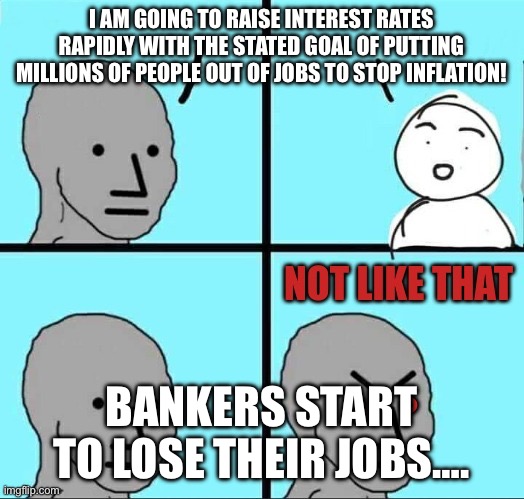Pretty sure the available for sale MBSs are marked to market every quarter meaning any losses as of 12/31/22 have already been accounted for. Held to Maturity is where you want to look for hidden paper losses that could blow up to real losses in a bank run.
My understanding is that the available for sale assets are marked to market every quarter, and HTM are not. HTM can hide current fair market losses on the balance sheet. However, in terms of being unable to handle a run on the bank, isn’t the issue liquidity and being able to sell AFS assets? If so, a broad liquidity crunch in MBSs means that the MBS portion of the AFS is not actually able to be sold, at least not at close to their fair value. As a result, they’d be susceptible to a run if the majority of their AFS securities are MBSs.
That’s my understanding. Agree?
As of 12/31, Truist has:
$5.3B cash
$16B deposits at other banks
$4.9B “trading assets”
$12B AFS non-MBS
$60B AFS MBS
So my understanding is that’s $98.2B available capital, up against something like $534B deposits. In a scenario where the AFS are not actually able to be liquidated, they only have approx $38B available.
They’ve got another $57B in MBSs HTM, which are probably worth something like $45B right now. So ballpark guess is that’s a hidden $12B loss.
In the event of a run, if the truth is that those AFS MBS’s are worth more like $45B than $60B and the $45B HTM is really worth more like $33B, that’s $27B in losses if they get liquidated - up against $43B of market cap.
Basically, my thinking here is that if there’s no run on Truist, they’ll be fine long-term, but it’s going to be a shitty few years for them. But if there’s a run, they could go in a firesale for like $7.50 a share or be liquidated by the FDIC and return like $12 a share to shareholders.
Question is, will there be a run? Probably depends what happens to First Republic, and/or whether anyone with a short position can orchestrate one.
I probably wouldn’t bet on it alone, but I love it as a hedge against my Citigroup trade with a chance to hit both.
As of last summer, K bank was worth over $3 a share in KT’s valuation ($14ish then). They canceled the IPO but haven’t gone under or anything. Based on the way banks are trading, by wild ass guess is that of the current $11.37 per share, K Bank is accounting for $1 to $2 of it. Given exposure to crypto and given what’s going on in the banking industry, K Bank going under seems very much in play. If it does, I’d expect KT to be worth about $9 to $10.50. So that’s 8% to 22% downside, and I don’t see a lot of upside opportunity at the moment.
I’d consider re-entering the position when the dust settles, and this may be a little risk-averse, but I also like having some extra dry powder in the current situation and this replenishes what I put into Citi.
Large interest rate based losses on Truist MBSs should already be baked in through 12/31/22. I guess what could happen is a temporary panic that Fannie and Freddie will blow up due to their own interest rate losses and cause a further collapse in Truist’s MBSs now that the Fannie/Freddie guarantee is no longer perceived as being rock solid.
Fannie / Freddie only lose money for the 1 month it takes them to package and sell mortgages. Also I assume (perhaps stupidly) that they have somewhat competent interest rate hedging occurring. They’re not going broke.
Well the fact that Fannie Mae is delaying a sale of MBS’s seems to make it possible there are liquidity issues in the MBS markets. If so, and if the AFS MBSs need to be sold, what are they actually worth right now?
I’m not saying any of this is a guarantee, far from it. The puts were cheap, and primarily a hedge on the Citi trade. I’m just saying if a big bank goes into a crisis, it’ll be Truist, and I think the 1-2 punch of a run and an MBS liquidity crunch could doom them. And those two things are strongly correlated.
Dunno all the details of how it all works other than they exist to provide guarantees to the mortgage market but know someone at one of the two at a relatively high level.
When interest rates were sub-3%, he told me he did an extensive analysis of their books and that if Freddie/Fannie were properly run companies subject to normal market forces then mortgage rates would be at least 5%. The difference in what rates were and what they should be was essentially risk buried in their books. He thought this was funny because his colleagues were itching to become private again and free of the government yoke.
Probably ponied, but obviously the important thing is to cram bonuses through before the music stops.
Employees earned those bonuses, if it was executives giving themselves millions of dollars for failing it’d be a different story.

SVB was the highest-paying publicly traded bank in 2018, with employees getting an average of $250,683 for that year, according to Bloomberg.
Who deserved the money more, employees or depositors?
Yeah he needs to go to jail.
VCs gonna do a victory lap since they graciously saved us by … doing nothing and/or actively contributing to the problem
lol at VCs “getting into the trenches”
They’re so insufferable.
Moody’s downgraded the entire US banking sector from stable to negative.
The correct response to anything from moodys:

I mean, given the fact that they tend to have stuff rated AAAAAAAAA+++++++++WESOME right before it goes under, I do get concerned when they downgrade stuff. I put no stock in their good ratings.